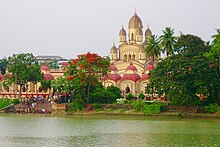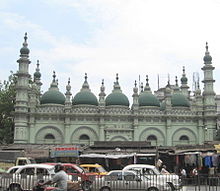Tourism in West Bengal: Difference between revisions
Tamravidhir (talk | contribs) →Rivers of West Bengal: illustrating |
Tamravidhir (talk | contribs) →Sea Beaches: adding info |
||
| Line 46: | Line 46: | ||
</center> |
</center> |
||
</gallery> |
</gallery> |
||
==Hill Stations== |
|||
There are many hill station in North West Bengal, of which [[Darjeeling]] is world famous. Others are [[Kurseong]], [[Kalimpong]], [[Rimbick]], [[Lava, West Bengal|Lava]] & [[Loleygaon]], [[Mirik]] and [[Sandakfu]]. |
|||
====Wildlife Sanctuaries and National Parks==== |
====Wildlife Sanctuaries and National Parks==== |
||
Revision as of 09:42, 28 May 2012
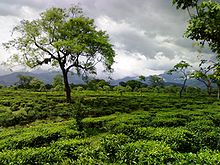

West Bengal Tourism refers to the Tourism in West Bengal, a state in the eastern region of India and is the nation's fourth-most populous.[1] It is also the seventh-most populous sub-national entity in the world, with over 91 million inhabitants.[1] Covering a total area of 34,267 sq mi (88,750 km2), it is bordered by the countries of Nepal, Bhutan, and Bangladesh, and the Indian states of Orissa, Jharkhand, Bihar, Sikkim, and Assam. The state capital is Kolkata (formerly Calcutta). West Bengal encompasses two broad natural regions: the Gangetic Plain in the south and the sub-Himalayan and Himalayan area in the north.
West Bengal is on the eastern bottleneck of India, stretching from the Himalayas in the north to the Bay of Bengal in the south. The state has a total area of 88,752 square kilometres (34,267 sq mi).[2] The Darjeeling Himalayan hill region in the northern extreme of the state belongs to the eastern Himalaya. This region contains Sandakfu (3,636 m or 11,929 ft)—the highest peak of the state.[3] The narrow Terai region separates this region from the plains, which in turn transitions into the Ganges delta towards the south. The Rarh region intervenes between the Ganges delta in the east and the western plateau and high lands. A small coastal region is on the extreme south, while the Sundarbans mangrove forests form a remarkable geographical landmark at the Ganges delta.
During the British colonial era from 1700–1912, when Kolkata (then known as Calcutta) was the capital of British India and , Kolkata witnessed a spate of frenzied construction activity of buildings largely influenced by the conscious intermingling of Neo-Gothic, Baroque, Neo-Classical, Oriental and Islamic schools of design. Unlike many north Indian cities, whose construction stresses minimalism, the layout of much of the architectural variety in Kolkata owes its origins to European styles and tastes imported by the British and, to a much lesser extent, the Portuguese and French.
Kolkata the state capital is considered to be an ideal hub to cover all the destinations in West Bengal.
Heritage
Architectural and Geographical


The state of West Bengal is rich in both architectural and natural heritage. The capital of the state, Kolkata is also known as the "City of Palaces". West Bengal is famous for its terracotta temples, especially those at Bishnupur. Hazarduari Palace is reputed to have the second largest chandelier in the world, after the one in the Buckingham Palace, London and also the largest staircase in India. It is also the chief tourist attraction of Murshidabad. This three storey palace was built in 1837 by Duncan McLeod for Nawab Nazim Humaun Jah, the then Nawab of Bengal, Bihar and Orissa. It has derived its name from the thousand doors in the palace (among which only 900 are real). In 1985, the palace was handed over to the Archaeological Survey of India [4][5] for better preservation. The Hazarduari Palace Museum is regarded as the biggest site museum of Archaeological Survey of India and has got 20 displayed galleries containing 4742 antiquities out of which 1034 has been displayed for the public. The antiquities include various weapons, oil paintings of Dutch, French and Italian artists, marble statues, metal objects, porcelain and stucco statues, farmans, rare books, old maps, manuscripts, land revenue records, palanquins mostly belonging to eighteenth and nineteenth centuries, a bamboo from Assam and so on.The palace has been built in European architectural style.
Some like the Victoria Memorial, Howrah Bridge (Rabindra Setu) and the Second Hooghly Bridge (Vidyasagar Setu) are iconic of Kolkata.Except the heritage buildings there are also high rising monuments and skyscrapers in the city. Except the colonial and heritage buildings there are also many cemeteries used by the British when Kolkata was the capital of British India, some of them are the South Park Street Cemetery and Scottish Cemetery, both in Kolkata.
The River Ganga, which is sacred flows through Kolkata. There are also some World heritage sites in West Bengal like Darjeeling Himalayan Railway and Sundarbans National Park. Neora Valley National Park, which is one of the richest biological zones in the entire Northeast situated in the Kalimpong subdivision under Darjeeling District in West Bengal. The Ganges Delta (also known as the Ganges–Brahmaputra Delta,[6] the Sunderbans Delta, or the Bengalla Delta) is a river delta in the South Asia region of Bengal, consisting of West Bengal and its neighbouring country of Bangladesh. It is the world's largest delta, and empties into the Bay of Bengal. It is also one of the most fertile regions in the world, thus earning the nickname "The Green Delta". The delta stretches from the Hooghly River on the west to the Meghna River on the east. It is approximately 350 km (220 mi) across at the Bay of Bengal.[6] Kolkata (formerly Calcutta) and Haldia in India and Mongla and Chittagong in Bangladesh are the principal seaports on the delta.


The Acharya Jagadish Chandra Bose Indian Botanic Garden or Calcutta Botanical Garden (previously known as Indian Botanic Garden)[7] is the largest and oldest reserve of greeneries of its kind in South East Asia. It is also a premier Institution for botanical and horticultural research in India. The Garden is situated on the West bank of River Hooghly in Shibpur, Howrah nearly 8 kms from center of city Kolkata. Located here is the Great Banyan Tree. It was the widest tree in the world in terms of the area of the canopy and is estimated to be about 200 to 250 years old. It became diseased after it was struck by lightning, so in 1925 the middle of the tree was excised to keep the remainder healthy; this has left it as a clonal colony, rather than a single tree. A 330 m long road was built around its circumference, but the tree continues to spread beyond it.
Other than these West Bengal has some more geographical attractions like Nakshi Kantha (Handicraft), Darjeeling tea (Agricultural), Santipore Saree (Handicraft), Shantiniketan Leather Goods (Handicraft), Fazli Mango (Agricultural), Khirsapati or Himsagar Mango (Agricultural), Laxman Bhog Mango (Agricultural), Baluchari Saree (Handicraft), and Dhaniakhali Saree (Handicraft).
- Architectural Wonders of West Bengal
-
The Howrah Bridge as seen from the Hooghly river.
-
The Second Hooghly Bridge illuminated at night.
-
Facade of the Victoria Memorial.
-
The Howrah Station is one of the four intercity train stations serving Howrah and Kolkata; the others are Sealdah Station, Shalimar Station and Kolkata railway station in Kolkata. Howrah is situated on the West bank of the Hooghly River, linked to Kolkata by the magnificent Howrah Bridge which is an icon of Kolkata. It is the oldest station and the largest railway complex in India.
-
Eden Gardens is a cricket ground in Kolkata. It is the home of the Bengal cricket team and the Indian Premier League's Kolkata Knight Riders, as well as being a venue for Test, One Day International and Twenty20 International matches.[8] The largest cricket stadium in India and second-largest in the world by seating capacity, it is widely acknowledged to be the most iconic cricket stadium in India. Eden Gardens has been called "cricket's answer to the Colosseum".[9]
-
Salt Lake Stadium is the second largest non-auto racing stadium in the world and the largest in the Indian sub-continent. It is currently used for football matches and athletics. The stadium was built in 1984 and holds 120,000[10] people in a three-tier configuration.
Sea Beaches
West Bengal stretches to the Bay of Bengal in the south. The coastal strip of West Bengal, extending from the Gangetic Delta to the border of Orissa has some beautiful coastal settlements namely Digha, Shankarpur, Mandarmani, Bakkhali, Gangasagara, Tajpur and more others. Some of these have, hard beaches on which cars can drive through. It is a fact that some decades ago, even aeroplanes were able to land in the beach of Digha.
-
Mandarmani Sea Beach
-
Sunset at Bakkhali
-
Social life in Digha
Hill Stations
There are many hill station in North West Bengal, of which Darjeeling is world famous. Others are Kurseong, Kalimpong, Rimbick, Lava & Loleygaon, Mirik and Sandakfu.
Wildlife Sanctuaries and National Parks


List of National Park in West Bengal:
- Buxa Tiger Reserve
- Gorumara National Park
- Neora Valley National Park
- Singalila National Park
- Sundarbans National Park
List of Wildlife Sanctuaries in West Bengal:
- Jaldapara Wildlife Sanctuary
- Adina Deer Park
- Ballabhpur Wildlife Sanctuary
- Bethuadahari Wildlife Sanctuary
- Bibhutibhushan Wildlife Sanctuary
- Chapramari Wildlife Sanctuary
- Haliday Island Wildlife Sanctuary
- Jore Pokhri Wildlife Sanctuary
- Lothian Island Wildlife Sanctuary
- Mahananda Wildlife Sanctuary
- Narendrapur Wildlife Sanctuary
- Ramnabagan Wildlife Sanctuary
- Sajnakhali Wildlife Sanctuary
- Senchal Wildlife Sanctuary

List of bird sanctuaries in west Bengal:
Rivers of West Bengal
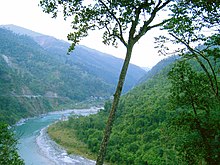
The following is a list of rivers in and around West Bengal:
Cultural
The culture of West Bengal has its roots in literature, music, fine arts, drama and cinema. But, the Darjeeling Himalayan hill region shows particularly different cultural aspect.
West Bengal's capital Kolkata—as the former capital of India—was the birthplace of modern Indian literary and artistic thought,[11] and is referred to as the "cultural capital of India".[12][13]
Para, Adda, and club culture
The presence of paras, which are neighbourhoods that possess a strong sense of community, is characteristic of West Bengal.[14] Typically, each para has its own community club and, on occasion, a playing field.[14] Residents engage in addas, or leisurely chats, that often take the form of freestyle intellectual conversation.[15][16] Typically, every para has its own community club, with a club room ("club ghar"), and often a playing field. People of a para habitually indulge in adda or leisurely chat in "rock"s or "rowacks" (porches) and teashops in the evenings after work. Sports (cricket, football, badminton) and indoor games (carrom) tournaments are regularly organized on an inter-para basis.
Religion, Inhabitants and Language
Majority of the population comprises Bengalis.[17] The Marwaris, Bihari and Oriya minority are scattered throughout the state; communities of Sherpas and ethnic Tibetans can be found in Darjeeling Himalayan hill region. Darjeeling district has a large number of Gurkha people of Nepalese origin. West Bengal is home to indigenous tribal Adivasis such as Santals, Kol, Koch-Rajbongshi and Toto tribe. There are a small number of ethnic minorities primarily in the state capital, including Chinese, Tamils, Gujaratis, Anglo-Indians, Armenians, Punjabis, and Parsis.[18] India's sole Chinatown is in eastern Kolkata.[19]
The official language is Bengali and English.[20] Nepali is the official language in three subdivisions of Darjeeling district.[20] As of 2001, in descending order of number of speakers, the languages of the state are: Bengali, Hindi, Santali, Urdu, Nepali, and Oriya.[20] Languages such as Rajbongshi and Ho are used in some parts of the state.
As of 2001, Hinduism is the principal religion at 72.5% of the total population, while Muslims comprise 25.2% of the total population , being the second-largest community as also the largest minority group; Sikhism, Christianity and other religions make up the remainder.[21]
Literature
The Bengali language boasts a rich literary heritage, shared with neighbouring Bangladesh. West Bengal has a long tradition in folk literature, evidenced by the Charyapada, Mangalkavya, Shreekrishna Kirtana, Thakurmar Jhuli, and stories related to Gopal Bhar. In the nineteenth and twentieth century, Bengali literature was modernized in the works of authors such as Bankim Chandra Chattopadhyay, Michael Madhusudan Dutt, Rabindranath Tagore, Kazi Nazrul Islam, Sharat Chandra Chattopadhyay, Jibananda Das and Manik Bandyopadhyay. In modern times Jibanananda Das, Bibhutibhushan Bandopadhyay, Tarashankar Bandopadhyay, Manik Bandopadhyay, Ashapurna Devi, Shirshendu Mukhopadhyay, Buddhadeb Guha, Mahashweta Devi, Samaresh Majumdar, Sanjeev Chattopadhyay and Sunil Gangopadhyay among others are well known.
West Bengal has a long tradition of popular literature, music and drama largely based on Bengali folklore and Hindu epics and Puranas.

Music and Dance
The Baul tradition is a unique heritage of Bengali folk music, which has also been influenced by regional music traditions.[24] Other folk music forms include Gombhira and Bhawaiya. Folk music in West Bengal is often accompanied by the ektara, a one-stringed instrument. West Bengal also has an heritage in North Indian classical music. "Rabindrasangeet", songs composed and set into tune by Rabindranath Tagore and "Nazrul geeti" (by Kazi Nazrul Islam) are popular. Also prominent are other musical forms like Dwijendralal, Atulprasad and Rajanikanta's songs, and "adhunik" or modern music from films and other composers.
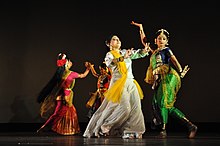
From the early 1990s, there has been an emergence and popularisation of new genres of music, including fusions of Baul and Jazz by several Bangla bands, as well as the emergence of what has been called Jeebonmukhi Gaan (a modern genre based on realism). Bengali dance forms draw from folk traditions, especially those of the tribal groups, as well as the broader Indian dance traditions. Chau dance of Purulia is a rare form of mask dance. State is known for Bengali folk music such as baul and kirtans and gajan, and modern songs including Bengali adhunik songs. From the early 1990s, there has been an emergence of new genres of music, including the emergence of what has been called Bengali Jeebonmukhi Gaan (a modern genre based on realism) by artists like Anjan Dutta, Kabir Suman, Nachiketa and folk/alternative/rock bands like Moheener Ghoraguli, Chandrabindoo, Bhoomi, Cactus and Fossils. Dutta's songs are influenced by classical music, and especially country music and blues and Bob Dylan and Leonard Cohen which he fused with Bengali tradition of east west, as did Suman. American urban folk and grunge are also an inspiration for this generation.[25]
Film and Theater

Mainstream Hindi films are popular in Bengal, and the state is home to a thriving cinema industry, dubbed "Tollywood". Tollygunj in Kolkata is the location of numerous Bengali movie studios, and the name "Tollywood" (similar to Hollywood and Bollywood) is derived from that name. The Bengali film industry is well known for its art films, and has produced acclaimed directors like Satyajit Ray, Mrinal Sen, Tapan Sinha and Ritwik Ghatak. Prominent contemporary directors include Buddhadev Dasgupta, Goutam Ghose, Aparna Sen and Rituparno Ghosh.
Among other types of theater, West Bengal has a tradition of folk drama known as jatra.[26][27] Kolkata is the home of the Bengali cinema industry, dubbed "Tollywood" for Tollygunj, where most of the state's film studios are located.[28] Its long tradition of art films includes globally acclaimed film directors such as Academy Award-winning director Satyajit Ray, Ritwik Ghatak, Mrinal Sen, Tapan Sinha, and contemporary directors such as Aparna Sen, Buddhadeb Dasgupta, and Rituparno Ghosh.[29]
Fine arts
Bengal had been the harbinger of modernism in fine arts. Abanindranath Tagore, called the father of Modern Indian Art had started the Bengal School of Art which was to create styles of art outside the European realist tradition which was taught in art colleges under the colonial administration of the British Government. The movement had many adherents like Gaganendranath Tagore, Ramkinkar Baij, Jamini Roy and Rabindranath Tagore. After Indian Independence, important groups like the Calcutta Group and the Society of Contemporary Artists were formed in Bengal which dominated the art scene in India.
Reformist heritage
The capital, Kolkata, was the workplace of several social reformers, like Raja Ram Mohan Ray, Iswar Chandra Vidyasagar, and Swami Vivekananda. These social reforms have eventually led to a cultural atmosphere where practices like sati, dowry, and caste-based discrimination or untouchability, the evils that crept into the Hindu society, were abolished.
Cuisine

Rice and fish are traditional favourite foods, leading to a saying in Bengali, machhe bhate bangali, that translates as "fish and rice make a Bengali".[30] Bengal's vast repertoire of fish-based dishes includes hilsa preparations, a favorite among Bengalis. There are numerous ways of cooking fish depending on the texture, size, fat content and the bones. Sweets occupy an important place in the diet of Bengalis and at their social ceremonies. It is an ancient custom among both Hindu and Muslim Bengalis to distribute sweets during festivities. The confectionery industry has flourished because of its close association with social and religious ceremonies. Competition and changing tastes have helped to create many new sweets. Bengalis make distinctive sweetmeats from milk products, including Rôshogolla, Chômchôm, Kalojam and several kinds of sondesh. Pitha, a kind of sweet cake, bread or dimsum are specialties of winter season. Sweets like coconut-naru, til-naru, moa, payesh, etc. are prepared during the festival of Lakshmi puja. Popular street food includes Aloor Chop, Beguni, Kati roll, and phuchka.[31][32]
The variety of fruits and vegetables that Bengal has to offer is incredible. A host of gourds, roots and tubers, leafy greens, succulent stalks, lemons and limes, green and purple eggplants, red onions, plantain, broad beans, okra, banana tree stems and flowers, green jackfruit and red pumpkins are to be found in the markets or anaj bazaar as popularly called. Panta bhat (rice soaked overnight in water)with onion & green chili is a traditional dish consumed in rural areas. Common spices found in a Bengali kitchen are cumin, ajmoda (radhuni), bay leaf, mustard, ginger, green chillies, turmeric, etc. People of erstwhile East Bengal use a lot of ajmoda, coriander leaves, tamarind, coconut and mustard in their cooking; while those aboriginally from West Bengal use a lot of sugar, garam masala and red chilli powder. Vegetarian dishes are mostly without onion and garlic.
Costumes

Bengali women commonly wear the shaŗi , often distinctly designed according to local cultural customs. In urban areas, many women and men wear Western attire. Among men, western dressing has greater acceptance. Men also wear traditional costumes such as the panjabi with dhuti, often on cultural occasions.
Festivals


Durga Puja in October is the most popular festival in the West Bengal.[33] Poila Baishakh (the Bengali New Year), Rathayatra, Dolyatra or Basanta-Utsab, Nobanno, Poush Parbon (festival of Poush), Kali Puja, SaraswatiPuja, LaxmiPuja, Christmas, Eid ul-Fitr, Eid ul-Adha and Muharram are other major festivals. Buddha Purnima, which marks the birth of Gautama Buddha, is one of the most important Hindu/Buddhist festivals while Christmas, called Bôŗodin (Great day) in Bengali is celebrated by the minority Christian population. Poush Mela is a popular festival of Shantiniketan, taking place in winter. West Bengal has been home to several famous religious teachers, including Sri Chaitanya, Sri Ramakrishna, Swami Vivekananda, A. C. Bhaktivedanta Swami Prabhupada and Paramahansa Yogananda. The swami is credited with introducing Hinduism to western society and became a religious symbol of the nation in the eyes of the intellectuals of the west.
Kumortuli
Kumortuli (also spelt Kumartuli, or the archaic spelling Coomartolly) is a traditionally potters’ quarter in North Kolkata. By virtue of their artistic productions these potters have moved from obscurity to prominence. This Kolkata neighbourhood, not only supplies clay idols of Hindu gods and goddesses to barowari pujas in Kolkata and its neighbourhoods, but a number of idols are exported.It is one of the seven wonders in Kolkata.[34]
Culture of Darjeeling Himalayan Hill Region

Apart from the major Hindu religious festivals like Diwali, Christmas, Dussera, Holi, Ram Navami, the diverse ethnic populace of Darjeeling Himalayan hill region celebrates several local festivals. The Tibetan ethnic groups like the Lepchas, Bhutias, Gurungs, and Tamangs celebrate new year called Losar in January/February, Maghe Sankranti, Chotrul Duchen, Buddha Jayanti, and Tendong Lho Rumfaat, to name a few, which provide the "regional distinctness" of Darjeeling's local culture from the rest of West Bengal.
A popular food in Darjeeling is the momo, a steamed dumpling containing either mutton, pork, beef or vegetables cooked in a doughy wrapping served with a watery vegetable soup and spicy tomato sauce/chutney. Wai-Wai is a favorite packaged snack of Darjeeling hills comprising noodles which are eaten either dry or with soup. Churpee, a kind of hard cheese made from cow or yak's milk is another popular mini-snack that is both nutritious and a pastime. A form of noodle called thukpa, served with soup and vegetables, is extremely popular in and around the hills of Darjeeling. Chhang and tongba are local alcoholic beverage made from millet.
Pilgrimages
Hinduism

People from different sections of the world come to West Bengal for holy pilgrimages as Kolkata is one of the four adi Shaktipeethas. Among the other 52 shaktipeethas some are located in West Bengal. They are as follows:
- Bardhaman
- Bahula, on the banks of Ajay river at Ketugram, 8 km from Katwa, Burdwan, West Bengal,.
- Ujaani, 16 km from Guskara station under Burdwan district of West Bengal.
- A temple locally known as Bhramari Devi. Behind a rice mill, near Jalpesh Temple in Jalpaiguri, West Bengal.
- Yoga Adya at Khirgram; under Burdwan district, West Bengal.
- Kalighat Kalipeeth in Kolkata.
- Kireet at Kireetkona village, 3 km from Lalbag Court Road station under Murshidabad district, West Bengal.
- Kankalitala, on the banks of Kopai River 10 km north-east of Bolpur station in Birbhum district. Devi locally known as Kankaleshwari.
- Vibhash, at Tamluk, under district Purba Medinipur, West Bengal.
- Tarapith and countless others.
Only one Maha Shaktipeethas known as Pradyumna, existed. This temple is currently non-existent. Only ruins are found in these places. Instead, Sringeri in Karnataka is believed to be the Shakti Peeth of this aspect of the Goddess.
Other than the shaktipeethas many other famous temples also exist. They are the famous Belur Math, Mayapur ISKCON Temple, Hangseshwari Temple, Tarakeshwar Temple and Dakshineswar Kali Temple.
-
The deity from Kalighat Kalipeeth.
-
Dakshineshwar Kali Temple as seen from the river.
-
The temple at Tarapith.
-
Belur Math is in Howrah.
Islam

There are countless mosques in West Bengal but some of them are very famous like the Nizamat Imambara in Murshidabad, Katra Mosque which is also in Murshidabad, Furfura Sharif and Tipu Sultan Shahi Mosque on Jawaharlal Nehru Road in Kolkata.
-
The exterior facade of the Katra Mosque.
-
The Tipu Sultan Shahi Mosque.
Gurudwaras
There are many Gurudwaras in West Bengal like Gurudwara Bari Sangat in Kolkata, Gurudwara Chhoti Sangat, Gurudwara Nima Serai Sri Guru Tegh Bahadur, Gurudwara Sikh Sangat and Gurudwara Liluah Belur Sikh Sangat in Liluah.
Christianism
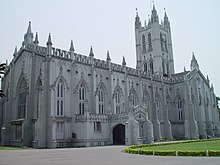
There are also many churches in West Bengal like the The Basilica of the Holy Rosary in Bandel, St. John's Church, St. Jame's Church (Jora Girja), St. Paul's Cathedral and Church of the Lord Jesus.

-
St. James Church is popularly known as Jora Girja (Twin Churches) due to its twin spires.
-
The Church of the Lord Jesus.
-
St. John's Church.
Buddhism
There are also many Buddhist Monasteries in West Bengal, especially in the hilly regions like the Ghoom Monastery, Bhutia Busty Monastery, Mag-Dhog Yolmowa Monastery, Tharpa Choling Monastery, Zang Dhok Palri Phodang and more others.
Seven Wonders of West Bengal


NDTV along with the Ministry of Tourism, Government of India conducted a nationwide campaign for searching the "Seven Wonders of India in 2008-09. The campaign started with shortlisting 200 places from all of the Indian states and then inviting public to cast their vote for their favorite places. It also included seven wonders of particular states. In West Bengal a total 13 were selected of which the "Seven Wonders of West Bengal" were shortlisted. The list of the 30 selected places are as follows:
- Cooch Behar Palace
- Darjeeling Himalayan Railway ("Toy Train")
- Hazarduari Palace
- Shantiniketan
- Bishnupur Terracotta Temples
- Acharya Jagadish Chandra Bose Indian Botanic Garden with the Great Banyan Tree
- Howrah Bridge
- B. B. D. Bagh (Formerly called, the Dalhousie Square)
- Dakshineswar Kali Temple
- Second Hooghly Bridge
- Victoria Memorial
- Sunderbans
- St. Paul's Cathedral
The shortlisted list, compiling of the "Seven Wonders of West Bengal" as per the votings is as follows:
- Sunderbans
- Victoria Memorial
- Darjeeling Himalayan Railway ("Toy Train")
- Bishnupur Terracotta Temples
- Acharya Jagadish Chandra Bose Indian Botanic Garden with the Great Banyan Tree
- Howrah Bridge
- B. B. D. Bagh (Formerly called, the Dalhousie Square)
Picture Gallery
-
Rasmancha built in 1600 AD. It is a platform for Vaishanva Ras Yatra Festival.
-
Jor-Bangla Temple or Keshta Roy Temple built in 1655 AD.
-
Firoz Minar in the ruined city of Gaur.
-
An ancient temple at Gaur.
-
A view of Kanchenjunga, as seen from Darjeeling.
-
Darjeeling to Ghoom Heritage Narrow Gauge Train, Ghum.
-
Plucking the tea leaves in traditional fashion, Darjeeling.
-
Darjeeling Himalayan Railway's famous "Toy Train" approaching Darjeeling.
-
Map of Darjeeling district.
-
Teesta River as seen from Jalpaiguri.
-
The idol of Lord Buddha inside Ghoom Monastery.
-
Zang Dhok Palri Phodang.
-
The Hazarduari Palace in Murshidabad - illuminated at night.
-
The Dakshin Darwaza (south gate) of the Hazarduari Palace.
-
The staircase leading to the upper portico of the palace, this staircase is perhaps the biggest one in India.
-
Kathgola Palace inside Kathgola, Murshidabad.
-
Murshidabad Clock Tower in the right seen with the Hazarduari Palace. It is locally known just as Clock Tower or Ghari Ghar, also known as "Big Ben of Murshidabad".
-
The Jahan Kosha Cannon in Murshidabad.
-
The Namak Haram Deorhi is in ruins.
-
A Royal Bengal Tiger in the Sunderbans.
-
The privately owned Marble Palace in Kolkata.
References
- ^ a b "India: Administrative Divisions (population and area)". Census of India. Retrieved April 17, 2009.
- ^ "Area, population, decennial growth rate and density for 2001 and 2011 at a glance for West Bengal and the districts: provisional population totals paper 1 of 2011: West Bengal". Registrar General & Census Commissioner, India. Retrieved 26 January 2012.
- ^ Pal, Supratim (14 May 2007). "Top of world in kingdom of cloud". The Telegraph. Kolkata. Retrieved 16 February 2012.
- ^ Palace handed ovet to ASI
- ^ Handed over to ASI
- ^ a b Merriam-Webster (1997). Merriam-Webster's geographical dictionary. Merriam-Webster. p. 412. ISBN 978-0-87779-546-9. Retrieved 23 April 2011.
- ^ "Indian Botanic Garden, Howrah." BSI. Web. 28 Feb. 2011. <http://164.100.52.111/indianBotanicgarden.shtm>
- ^ "Eden Gardens". CricInfo. Retrieved 2009-04-12.
- ^ "India keep winning - but the crowds stay away". BBC news. Retrieved 25 October 2011.
- ^ East Bengal Football Club
- ^ Chaudhuri, Nirad C. (2001). The autobiography of an unknown Indian. New York Review of Books. p. 269. ISBN 978-0-940322-82-0.
- ^ Reeves, Philip (5 April 2007). "Calcutta: habitat of the Indian intellectual". National Public Radio. Retrieved 29 January 2012.
- ^ Noble, Allen and Frank Costa (1990). Regional development and planning for the 21st century : new priorities, new philosophies. Ashgate Pub Ltd. pp. 282, 396. ISBN 978-1-84014-800-8.
{{cite book}}: Unknown parameter|coauthors=ignored (|author=suggested) (help) - ^ a b "Kolkata culture: Para". Department of Tourism, Government of West Bengal. Retrieved 9 December 2011.
- ^ Trachtenberg, P. (15 May 2005). "The chattering masses". The New York Times. Retrieved 26 April 2006.
- ^ Mukherjee Pandey, Jhimli (1 November 2008). "Presidency old-timers to relive days of canteen adda". Times of India. Retrieved 23 January 2012.
- ^ Hoddie, Matthew (2006). Ethnic realignments: a comparative study of government influences on identity. Lexington Books. pp. 114–115. ISBN 978-0-7391-1325-7. Retrieved 16 February 2012.
- ^ Banerjee, Himadri; Gupta, Nilanjana; Mukherjee, Sipra, eds. (2009). Calcutta mosaic: essays and interviews on the minority communities of Calcutta. Anthem Press. p. 3. ISBN 978-81-905835-5-8. Retrieved 29 January 2012.
- ^ Banerjee, Himadri; Gupta, Nilanjana; Mukherjee, Sipra, eds. (2009). Calcutta mosaic: essays and interviews on the minority communities of Calcutta. Anthem Press. pp. 9–10. ISBN 978-81-905835-5-8. Retrieved 29 January 2012.
- ^ a b c "Report of the Commissioner for linguistic minorities: 47th report (July 2008 to June 2010)" (PDF). Commissioner for Linguistic Minorities, Ministry of Minority Affairs,
Government of India. pp. 122–126. Retrieved 16 February 2012.
{{cite web}}: line feed character in|publisher=at position 70 (help) - ^ "Data on Religion". Census of India (2001). Office of the Registrar General & Census Commissioner, India. Archived from the original on August 12, 2007. Retrieved August 26, 2006.
- ^
Georg, Feuerstein (2002). The Yoga Tradition. Motilal Banarsidass. p. 600. ISBN 3-935001-06-1.
{{cite book}}: Cite has empty unknown parameter:|coauthors=(help) - ^ Clarke, Peter Bernard (2006). New Religions in Global Perspective. Routledge. p. 209. ISBN 0-7007-1185-6.
- ^ "The Bauls of Bengal". Folk Music. BengalOnline. Retrieved October 26, 2006.
- ^ "Chau: The Rare Mask Dances". Dances of India. Boloji.com. Retrieved October 22, 2006.
- ^ Chakraborty, Ajanta (5 July 2011). "Meet the new Mamata Banerjee". Times of India. Retrieved 23 January 2012.
The jatra industry based out of Kolkata's Chitpur Road has gone through a severe blow with the growth of video parlours.
- ^ Niyogi, Subhro (26 October 2010). "Red alert For Jatra". Times of India. Retrieved 23 January 2012.
- ^ Sarkar, Bhaskar (March 2008). "The melodramas of globalization". Cultural Dynamics. 20 (1): pp. 31–51 [34]. doi:10.1177/0921374007088054.
{{cite journal}}:|pages=has extra text (help)CS1 maint: date and year (link). - ^ Gooptu, Sharmistha (2010). Bengali cinema: 'an other nation'. Taylor & Francis. pp. 2, 172, 181, 187. ISBN 978-0-415-57006-0. Retrieved 24 January 2012.
- ^ Gertjan de Graaf, Abdul Latif. "Development of freshwater fish farming and poverty alleviation: A case study from Bangladesh" (PDF). Aqua KE Government. Retrieved October 22, 2006.
- ^ Saha, S (January 18, 2006). "Resurrected, the kathi roll – Face-off resolved, Nizam's set to open with food court". Calcutta, India: The Telegraph (Kolkata). Retrieved October 26, 2006.
- ^ "Mobile food stalls". Bangalinet.com. Retrieved October 26, 2006.
- ^ "Durga Puja". Festivals celebrated throughout West Bengal. Department of Tourism, Government of West Bengal. Retrieved 5 March 2012.
- ^ "Seven wonders of Kolkata". The Times Of India.





![Eden Gardens is a cricket ground in Kolkata. It is the home of the Bengal cricket team and the Indian Premier League's Kolkata Knight Riders, as well as being a venue for Test, One Day International and Twenty20 International matches.[8] The largest cricket stadium in India and second-largest in the world by seating capacity, it is widely acknowledged to be the most iconic cricket stadium in India. Eden Gardens has been called "cricket's answer to the Colosseum".[9]](http://upload.wikimedia.org/wikipedia/commons/thumb/f/fc/Eden_gardens_ipl_2011.jpg/125px-Eden_gardens_ipl_2011.jpg)
![Salt Lake Stadium is the second largest non-auto racing stadium in the world and the largest in the Indian sub-continent. It is currently used for football matches and athletics. The stadium was built in 1984 and holds 120,000[10] people in a three-tier configuration.](http://upload.wikimedia.org/wikipedia/commons/thumb/c/c8/Salt_Lake_Stadium_-_Yuva_Bharati_Krirangan%2C_Kolkata.jpg/125px-Salt_Lake_Stadium_-_Yuva_Bharati_Krirangan%2C_Kolkata.jpg)



